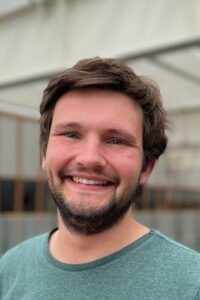Adriaan Duijndam
Recently, the environmental presence of micro- and nanoplastics (MNP), which are plastic particles with a size of <5 mm and <1 µm, respectively, has become an issue of high priority1. A major knowledge gap concerns the impact of MNP on human health2. The POLYRISK consortium, which my project is part of, aims to assess this impact3. To do so, my research includes the characterization of reference MNP materials, as well as the analysis MNP out of spiked cell cultures, human samples (e.g. blood or saliva) and abiotic samples (air, water). I am particularly interested assessing polymer type, size and morphology of the nanoplastic fraction of such samples. This has recently been shown to be possible using photo-induced force microscopy (PiFM)4. This is a powerful analytical technique that combines the spatial resolution of atomic force microscopy with the chemical information of infrared spectroscopy5. As direct analysis of nanoplastics with PiFM is not possible for most samples, a large part of my project will focus on the development of pretreatment procedures, aiming to facilitate the measurement of nanoplastics even in challenging matrices.
- da Costa, J. P. et al. (Nano)plastics in the environment – Sources, fates and effects. Sci. Total Environ. 566–567, 15–26 (2016).
- Revel, M. et al. Micro(nano)plastics: A threat to human health? Curr. Opin. Environ. Sci. Heal. 1, 17–23 (2018).
- POLYRISK. Risk of microplastics and nanoplastic particles. https://polyrisk.science/.
- Have, I. C. et al. Photoinduced Force Microscopy as an Efficient Method Towards the Detection of Nanoplastics. Chem. Methods 1, 205–209 (2021).
- Nowak, D. et al. Nanoscale chemical imaging by photoinduced force microscopy. Sci. Adv. 2, (2016).

